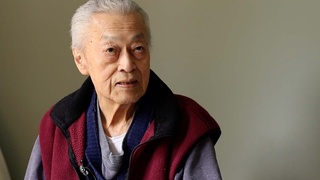Interviews
The Dopey bank that survived the war
And then of course, the character that made the big impression on me was this little guy. And so after the movie, we traditionally always used to go to our local Woolworth five and dime, and they had a soda fountain there. And we would go get a hot dog or root beer float or whatever. And then we wandered over to the toy department and this was on the shelf. This is the little Dopey bank. And so, I said, “Oh! I want that, Daddy.” So my dad bought this for me. And then, you know, we got home and I went upstairs and I put it on my dresser. And I would put my pennies and allowance and all that.
And then the war started. And then we all had to go to camp. But I remember that one day that I came home from school and the FBI agents were over. Going through a lot of our personal belongings, confiscating our contraband. One of the things my dad had was an heirloom katana sword. That was gone. And then I think, things like cameras and whatever that was considered contraband. So that scared the—heck out of me. So I ran upstairs and went into my bedroom and sitting on my dresser was Dopey. I was relieved, I said, “Oh my gosh, they didn’t confiscate this little guy.” Well, eventually we ended up going to camp. And taking only what you could carry. Things like this, you know...
So after three years, we returned and I remember the first thing I did when we got to our home was run upstairs and there was this little Dopey, still on the dresser. I kind of shook it, but my pennies were gone. But I was so relieved that my Dopey was still. And so it's been with me all these years, since I was five years old, and I’m 81 now.
Date: August 26, 2015
Location: California, US
Interviewer: John Esaki
Contributed by: Watase Media Arts Center, Japanese American National Museum
Explore More Videos

Sister’s Trauma from being Incarcerated during World War II
(b. 1932) Nisei American stage, film, and TV actress

FBI agents came to the house while parents were gone
(b. 1923) Japanese American poet, activist

Mother was ordered to speak English during FBI house search
(b. 1923) Japanese American poet, activist

School held emergency drills at the start of World War II
(1934–2018) Japanese American designer, educator, and pioneer of media technologies

Father lost everything during World War II
(1934–2018) Japanese American designer, educator, and pioneer of media technologies

His family Traveled to Japan in 1940
(b. 1938) Japanese American. Hiroshima atomic bomb survivor

His Memory of August 6, 1945
(b. 1938) Japanese American. Hiroshima atomic bomb survivor

Escape from Hiroshima
(b. 1938) Japanese American. Hiroshima atomic bomb survivor

Returning to Hiroshima in ruins
(b. 1938) Japanese American. Hiroshima atomic bomb survivor

Overcoming trauma and speaking about his A-Bomb experience
(b. 1938) Japanese American. Hiroshima atomic bomb survivor

Family having to hide guns during World War II in Colombia
(b.1974) Japanese Colombian who currently resides in the United States

Japanese were treated with dignity during WWII (Spanish)
(b.1974) Japanese Colombian who currently resides in the United States

Enjoying undokai and sports in Crystal City
(b. 1936) Japanese Peruvian incarcerated in Crystal City

Kids activities in Crystal City
(b. 1938) Japanese Peruvian incarcerated in Crystal City

Having nowhere to go postwar
(b. 1938) Japanese Peruvian incarcerated in Crystal City
